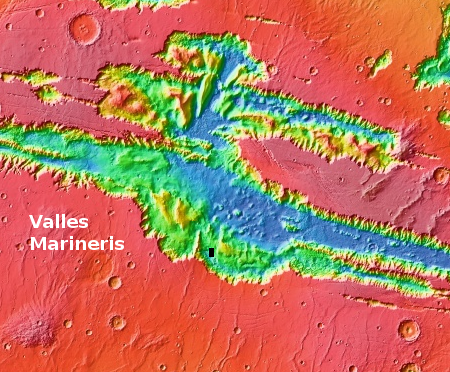Paisley terrain on Mars
Cool image time! The photo to the right, cropped and reduced to post here, is actually a somewhat old image from the high resolution camera on Mars Reconnaissance Orbiter (MRO). It was taken more than a decade ago, on December 28, 2010, and featured as a captioned image one month later. I post it now because it was recently featured as MRO’s picture of the day, and thought it deserved a new look. As the caption from 2010, written by planetary scientist Alfred McEwen, noted,
Remember those paisley shirts during the summer of love in 1967? If so, this terrain may look somewhat familiar.
How did this terrain really form? One theory is that it’s a landslide deposit, perhaps associated with draining an ancient lake.
The overview map below might help make sense of this theory.

The black box marks the location of this paisley terrain, on the southern slopes of 2,000-mile-long Valles Marineris, the biggest known canyon in the solar system. At this point the canyon is at its widest at about 200 miles across.
Being on those southern slopes suggests the landside theory has some merit. Then again, the slopes here extend for many tens of miles, which make their downward grade to the north somewhat uneven. The terrain itself also appears relatively flat, though in the full image there appears to be a slight downward trend to the northeast. Where are the landslides?
The feature could possibly be caused by wind-erosion. Maybe we are looking at the bottom of what was once a lake that is now eroding being exposed to wind and sun and seasonal climate changes Or not.
I did some digging and could find no studies of this geology. It remains a mystery for some future planetary geologist to decipher, possibly one who is right now in elementary school and will figure it out, on the surface of Mars itself.
On Christmas Eve 1968 three Americans became the first humans to visit another world. What they did to celebrate was unexpected and profound, and will be remembered throughout all human history. Genesis: the Story of Apollo 8, Robert Zimmerman's classic history of humanity's first journey to another world, tells that story, and it is now available as both an ebook and an audiobook, both with a foreword by Valerie Anders and a new introduction by Robert Zimmerman.
The print edition can be purchased at Amazon or from any other book seller. If you want an autographed copy the price is $60 for the hardback and $45 for the paperback, plus $8 shipping for each. Go here for purchasing details. The ebook is available everywhere for $5.99 (before discount) at amazon, or direct from my ebook publisher, ebookit. If you buy it from ebookit you don't support the big tech companies and the author gets a bigger cut much sooner.
The audiobook is also available at all these vendors, and is also free with a 30-day trial membership to Audible.
"Not simply about one mission, [Genesis] is also the history of America's quest for the moon... Zimmerman has done a masterful job of tying disparate events together into a solid account of one of America's greatest human triumphs."--San Antonio Express-News
Cool image time! The photo to the right, cropped and reduced to post here, is actually a somewhat old image from the high resolution camera on Mars Reconnaissance Orbiter (MRO). It was taken more than a decade ago, on December 28, 2010, and featured as a captioned image one month later. I post it now because it was recently featured as MRO’s picture of the day, and thought it deserved a new look. As the caption from 2010, written by planetary scientist Alfred McEwen, noted,
Remember those paisley shirts during the summer of love in 1967? If so, this terrain may look somewhat familiar.
How did this terrain really form? One theory is that it’s a landslide deposit, perhaps associated with draining an ancient lake.
The overview map below might help make sense of this theory.

The black box marks the location of this paisley terrain, on the southern slopes of 2,000-mile-long Valles Marineris, the biggest known canyon in the solar system. At this point the canyon is at its widest at about 200 miles across.
Being on those southern slopes suggests the landside theory has some merit. Then again, the slopes here extend for many tens of miles, which make their downward grade to the north somewhat uneven. The terrain itself also appears relatively flat, though in the full image there appears to be a slight downward trend to the northeast. Where are the landslides?
The feature could possibly be caused by wind-erosion. Maybe we are looking at the bottom of what was once a lake that is now eroding being exposed to wind and sun and seasonal climate changes Or not.
I did some digging and could find no studies of this geology. It remains a mystery for some future planetary geologist to decipher, possibly one who is right now in elementary school and will figure it out, on the surface of Mars itself.
On Christmas Eve 1968 three Americans became the first humans to visit another world. What they did to celebrate was unexpected and profound, and will be remembered throughout all human history. Genesis: the Story of Apollo 8, Robert Zimmerman's classic history of humanity's first journey to another world, tells that story, and it is now available as both an ebook and an audiobook, both with a foreword by Valerie Anders and a new introduction by Robert Zimmerman.
The print edition can be purchased at Amazon or from any other book seller. If you want an autographed copy the price is $60 for the hardback and $45 for the paperback, plus $8 shipping for each. Go here for purchasing details. The ebook is available everywhere for $5.99 (before discount) at amazon, or direct from my ebook publisher, ebookit. If you buy it from ebookit you don't support the big tech companies and the author gets a bigger cut much sooner.
The audiobook is also available at all these vendors, and is also free with a 30-day trial membership to Audible.
"Not simply about one mission, [Genesis] is also the history of America's quest for the moon... Zimmerman has done a masterful job of tying disparate events together into a solid account of one of America's greatest human triumphs."--San Antonio Express-News



Marvin and K-9 have places to play Hide and Seek with he Mars Rover